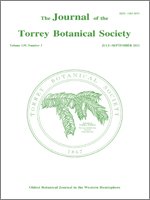Wyckoff, P. H., R. Greiman, A. Krueger, and L. Luce. (Biology Discipline, University of Minnesota, Morris, MN 56267). Forest dynamics at Minnesota's prairie-forest border driven by invasive buckthorn (Rhamnus cathartica) and native bur oak (Quercus macrocarpa). J. Torrey Bot. Soc. 139: 311–322. 2012.—Quercus macrocarpa Michx. (bur oak) is the key pioneer species as forests establish at the prairie-forest ecotone in western Minnesota, but invasive Rhamnus cathartica L. (European buckthorn) is an abundant and increasing secondary tree. Here we contrast microsite utilization and growth as a function of light and soil moisture for Q. macrocarpa and R. cathartica saplings at an ecotonal forest in an effort to establish the roles these two species are likely to play in near-term forest dynamics. Compared to Q. macrocarpa, R. cathartica saplings are found, on average, in darker microsites (P < 0.001) with higher soil moisture (P < 0.001), though the range of light levels at which saplings were seen to occur is much larger for Q. macrocarpa than for R. cathartica. We fit a variety of models which predict sapling growth and compared fits using AICc. With our best fitting models, light, size, and soil moisture together explain approximately half of the variation in growth among R. cathartica saplings and two-thirds of the variation in Q. macrocarpa. Most similar studies utilize models that include an a priori assumption that growth will asymptote with increasing light availability, but we find no evidence to support the use of asymptotic models. All top ranked models include light and sapling size, but the calculated importance of both light and soil moisture is dependent on the choice of growth metric, a disturbing finding given the variety of metrics utilized in the sapling growth literature. For neither species does the addition of soil moisture significantly improve growth models if the growth metric used is absolute radial stem growth increment, but soil moisture becomes important when absolute basal area increment is the growth metric for Q. macrocarpa, and when relative growth increment is used for either species. Limited success of R. cathartica in light, dry microsites suggests that the invasive tree may be near its climatic limit at our ecotonal forest site. At the same time, the relative success of the species in the dark understory of our warm dry forest suggests that near-term warming, with an expected increase in continental-climate drought, is unlikely to limit R. cathartica across the bulk of forests it has invaded in North America.
How to translate text using browser tools
1 July 2012
Forest dynamics at Minnesota's prairie-forest border driven by invasive buckthorn (Rhamnus cathartica) and native bur oak (Quercus macrocarpa)
Peter H. Wyckoff,
Ruth Greiman,
Anthony Krueger,
Logan Luce
ACCESS THE FULL ARTICLE
invasive species
prairie-forest ecotone
Quercus macrocarpa
Rhamnus cathartica
sapling growth





